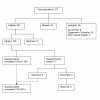Patterns of analgesic use, pain and self-efficacy: a cross-sectional study of patients attending a hospital rheumatology clinic
- PMID: 19903350
- PMCID: PMC2777148
- DOI: 10.1186/1471-2474-10-137
Patterns of analgesic use, pain and self-efficacy: a cross-sectional study of patients attending a hospital rheumatology clinic
Abstract
Background: Many people attending rheumatology clinics use analgesics and non-steroidal anti-inflammatories for persistent musculoskeletal pain. Guidelines for pain management recommend regular and pre-emptive use of analgesics to reduce the impact of pain. Clinical experience indicates that analgesics are often not used in this way. Studies exploring use of analgesics in arthritis have historically measured adherence to such medication. Here we examine patterns of analgesic use and their relationships to pain, self-efficacy and demographic factors.
Methods: Consecutive patients were approached in a hospital rheumatology out-patient clinic. Pattern of analgesic use was assessed by response to statements such as 'I always take my tablets every day.' Pain and self-efficacy (SE) were measured using the Western Ontario and McMaster Universities Osteoarthritis Index (WOMAC) and Arthritis Self-Efficacy Scale (ASES). Influence of factors on pain level and regularity of analgesic use were investigated using linear regression. Differences in pain between those agreeing and disagreeing with statements regarding analgesic use were assessed using t-tests.
Results: 218 patients (85% of attendees) completed the study. Six (2.8%) patients reported no current pain, 26 (12.3%) slight, 100 (47.4%) moderate, 62 (29.4%) severe and 17 (8.1%) extreme pain. In multiple linear regression self efficacy and regularity of analgesic use were significant (p < 0.01) with lower self efficacy and more regular use of analgesics associated with more pain.Low SE was associated with greater pain: 40 (41.7%) people with low SE reported severe pain versus 22 (18.3%) people with high SE, p < 0.001. Patients in greater pain were significantly more likely to take analgesics regularly; 13 (77%) of those in extreme pain reported always taking their analgesics every day, versus 9 (35%) in slight pain. Many patients, including 46% of those in severe pain, adjusted analgesic use to current pain level. In simple linear regression, pain was the only variable significantly associated with regularity of analgesic use: higher levels of pain corresponded to more regular analgesic use (p = 0.003).
Conclusion: Our study confirms that there is a strong inverse relationship between self-efficacy and pain severity. Analgesics are often used irregularly by people with arthritis, including some reporting severe pain.
Similar articles
-
A randomized study to evaluate the analgesic efficacy of a single dose of the TRPV1 antagonist mavatrep in patients with osteoarthritis.Scand J Pain. 2017 Oct;17:134-143. doi: 10.1016/j.sjpain.2017.07.021. Epub 2017 Aug 24. Scand J Pain. 2017. PMID: 28850367 Clinical Trial.
-
Analgesic treatment for moderate-to-severe acute pain in the United States: patients' perspectives in the Physicians Partnering Against Pain (P3) survey.J Opioid Manag. 2011 Jul-Aug;7(4):277-86. doi: 10.5055/jom.2011.0069. J Opioid Manag. 2011. PMID: 21957827
-
Does chronic daily headache arise de novo in association with regular use of analgesics?Headache. 2003 Mar;43(3):179-90. doi: 10.1046/j.1526-4610.2003.03041.x. Headache. 2003. PMID: 12603636
-
Management of chronic arthritis pain in the elderly.Drugs Aging. 2010 Jun 1;27(6):471-90. doi: 10.2165/11536530-000000000-00000. Drugs Aging. 2010. PMID: 20524707 Review.
-
Clinical pharmacology of analgesics assessed with human experimental pain models: bridging basic and clinical research.Br J Pharmacol. 2013 Feb;168(3):534-53. doi: 10.1111/bph.12023. Br J Pharmacol. 2013. PMID: 23082949 Free PMC article. Review.
Cited by
-
Patterns of pain medication usage and self-reported pain in older Irish adults with osteoarthritis: A latent class analysis of data from the Irish Longitudinal Study on Ageing.BMC Musculoskelet Disord. 2024 Oct 2;25(1):773. doi: 10.1186/s12891-024-07854-8. BMC Musculoskelet Disord. 2024. PMID: 39358713 Free PMC article.
-
Modifiable lifestyle factors are associated with lower pain levels in adults with knee osteoarthritis.Pain Res Manag. 2015 Sep-Oct;20(5):241-8. doi: 10.1155/2015/389084. Epub 2015 Jun 30. Pain Res Manag. 2015. PMID: 26125195 Free PMC article.
-
The Effects of Adherence to Non-Steroidal Anti-Inflammatory Drugs and Factors Influencing Drug Adherence in Patients with Knee Osteoarthritis.J Korean Med Sci. 2016 May;31(5):795-800. doi: 10.3346/jkms.2016.31.5.795. Epub 2016 Mar 29. J Korean Med Sci. 2016. PMID: 27134504 Free PMC article.
-
Prescribing Pattern of Analgesics in Colombia. Are there Differences between Capital Cities and Municipalities? A Cross-Sectional Study.Drugs Real World Outcomes. 2022 Sep;9(3):487-501. doi: 10.1007/s40801-022-00318-2. Epub 2022 Jul 11. Drugs Real World Outcomes. 2022. PMID: 35819624 Free PMC article.
-
Validation and Assessment of Osteoporosis Self-Efficacy Among Iraqi General Population.Open Nurs J. 2018 May 31;12:76-85. doi: 10.2174/1874434601812010076. eCollection 2018. Open Nurs J. 2018. PMID: 29997710 Free PMC article.
References
MeSH terms
Substances
LinkOut - more resources
Full Text Sources
Medical


